One of the most interesting and important discoveries at the Temple Mount Excavations directed from 1968 till 1978 by the late Prof. Benjamin Mazar, was made at the southwest corner in 1969. After digging through Umayyad, Byzantine and Roman destruction levels, a large corner parapet stone was found lying on its side on the paving stones of the Herodian street, about 1.5 meter (5 feet) from the southwest corner. A niche was cut out of the inner slope of the stone on its southern side. Above this niche was an inscription written in Hebrew, which reads (from right to left) “l’bet hatqia l’hakh . . . ”
 The first two words “l’bet hatqia” mean “to the place of trumpeting,” but the last Hebrew word is incomplete. Scholars have suggested completing the inscription with l’hekhal (to the Temple), l’ha-kohn (for the priest) or “l’hakhriz,” (announce). The latter suggestion, which would make the inscription read, “to the place of trumpeting to announce”, has the most support.
The first two words “l’bet hatqia” mean “to the place of trumpeting,” but the last Hebrew word is incomplete. Scholars have suggested completing the inscription with l’hekhal (to the Temple), l’ha-kohn (for the priest) or “l’hakhriz,” (announce). The latter suggestion, which would make the inscription read, “to the place of trumpeting to announce”, has the most support.
As it was found lying directly on the street and underneath other fallen Herodian stones, it must originally have been located at the top of the southwest corner whence it was the first stone to have been thrown down.
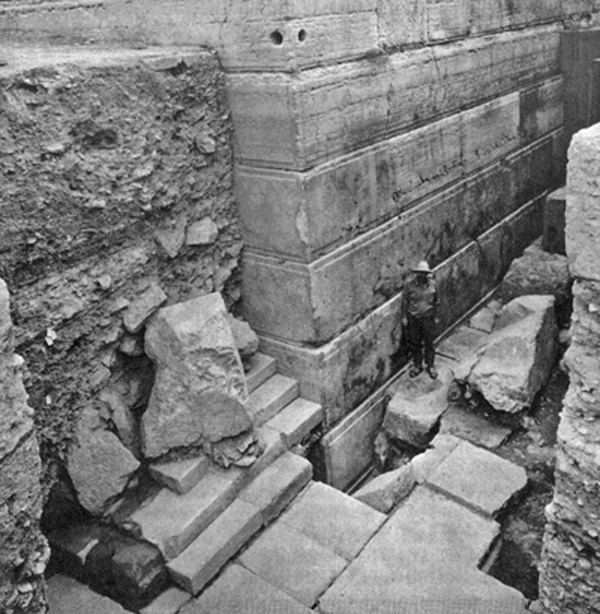
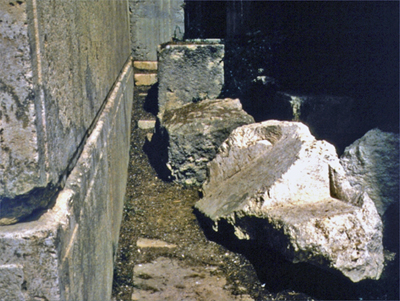
Why was this find so important?
There are people, mainly in America, such as the ones mentioned in a previous blog, that deny that the Temple Mount is the place where the Jewish Temple once stood. They suggest, based on the misreading of certain Scripture passages, that it stood in the City of David. 1
The problem for people like that is that the Temple Mount walls are still standing, so they identify the Temple Mount with the Antonia Fortress, being apparently ignorant of the fact that Josephus wrote: “Titus now ordered the troops that were with him to raze the foundations of Antonia …” (War 6.93). Indeed, as I will point out in a future blog, archaeology has proved this to be a true statement.
This Hebrew inscription therefore disproves the idea that the Temple Mount was somewhere else. Another Hebrew inscription found near the same place reads “korban”, which means sacrifice. Just below the inscription are two doves or pigeons inscribed upside down.
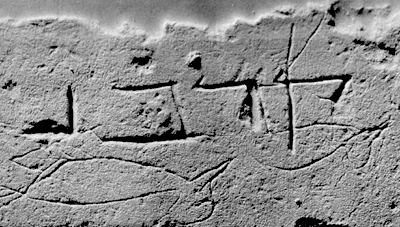
This inscription vividly illuminates the event when Jesus drove out the money changers and those that sold doves out of the Temple (Matt. 21:12; Mark 11:15). It is impossible to suggest that Hebrew inscriptions of this kind once belonged to a Roman fortress.
High above this corner stood the Royal Stoa, so that the Trumpeting Stone was located some 138 feet (42 m) above street level. From this elevated position, a trumpet call could be heard all over the city.
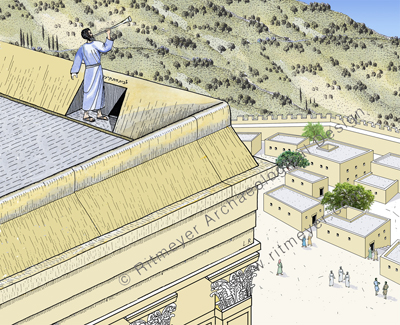
An interesting side question is how the part of the Trumpeting stone with the inscription was broken. Any stone, falling from such a great height, would probably have been broken. However, there is a possibility that in this case the stone was not broken to its present extent by the Roman destruction of A.D. 70. In 1867, Charles Warren investigated this area and dug through the fallen debris down to the bedrock right beside the corner. When reconstructing the outline of Warren’s shaft, it becomes clear that the stone would have protruded into the dark shaft. This raises the possibility that part of the Trumpeting Stone may have been accidentally smashed by Warren’s workmen before they pierced the paving slabs in order to dig down to bedrock.
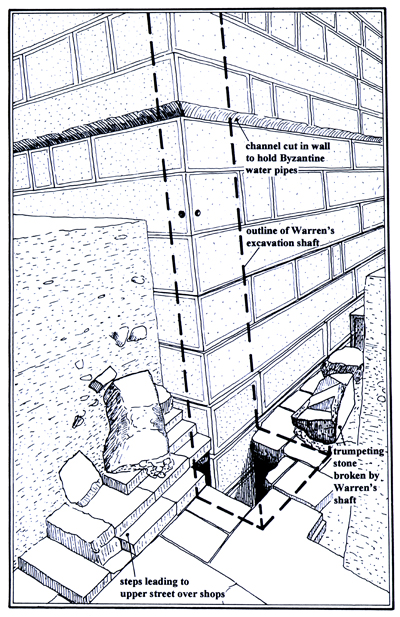
- In a recent interview, Bob Cornuke, who has fully accepted Ernest Martin’s idea that the Temple stood in the City of David, falsely claimed the following: “But the man that came up with this idea of the Temple being there was Benjamin Mazar, who is the grandfather of archaeology in Jerusalem. He is considered, just like he’s the George Washington of archaeology. He told this theory to Dr. Ernest Martin. Ernest Martin worked for him on a dig and said, ‘Ernest, this is where it is. It’s in the City of David. All the evidence we are finding is in the City of David. (HT Gordon Franz)

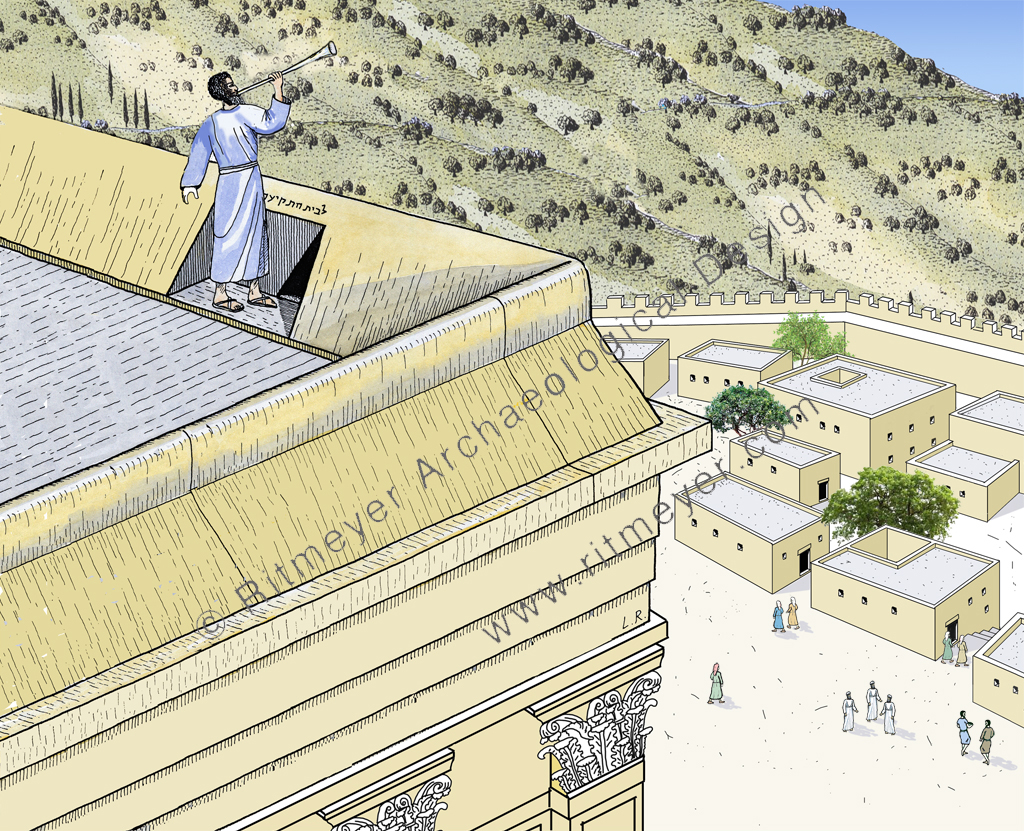
Hello Sir,
Sure, this stone is one of the evidences that the Temple mount is the good place where the Sanctuary stood !
Jacquy, yes, this stone with its inscription undoubtedly proves that the Sanctuary stood on the Temple Mount. There is much more evidence, but this is one of the best.
How is it that a man like Bob Cornuke, who has consistently produced the most flaky theories on all sorts of issues, has not been laughed out of town? How anyone can take anything he says seriously is just incredible.
Thank you SO much Mr. Ritmeyer for your solid and trustworthy research. You are a voice of sanity in a world where the inmates are progressively taking over the asylum.
Thank you, David. Fortunately these strange ideas are mostly limited to USA audiences. In their so-called zeal for Scripture they swallow a camel and strain out a gnat!
Leen, thank you for providing background for this very important discovery. Besides providing evidence for the place of the temple, do you think it also helps locating “the pinnacle of the temple”? The Greek words refer to the temple complex in general (hieron rather than naos) and to “the wing” or the extremity of something (pterugion). Would this stone help pin-pointing a place discussed since the Byzantine era?
Once again Leen, I would like to thank you for addressing the persistent “temple location” confusion. I frequently get questioned as to my point of view on the “City of David” location theory. Directing the inquisitive to your blog is a real asset. It is important and useful to remind readers that you worked directly for Dr. Benjamin Mazar and you were also a contemporary of Ernest L. Martin, as both of you were there in Jerusalem during the same timeframe. Your personal involvement with Mazar’s team as these things were discovered, and your role as archaeological illustrator make you a primary authority on this topic. I am grateful that you continue to publish materials that address this needless controversy. Thanks again.
Thanks, Daniel for your encouragement. To suggest that the Temple was in the City of David is ludricous. For a while I didn’t want to address this silly idea, but then I thought that it may be helpful for some people who don’t have the means to disprove it. I have a few more proofs coming soon to show that the Temple stood on what most people know is the Temple Mount.
Morten,
it makes more sense that Jesus, when he was tempted, had the southwest corner of the Temple Mount in mind, not only because of the Trumpeting Stone, but also, as it was a busy intersection, many more people could have watched it.
I have been a tour director to groups in Israel and made a special point of showing the significance of this stone. I also told them about the significance of the special ancient step on the western steps adjacent to the Dome of the Rock. Thanks for pointing that out in your book.
Too bad Warren’s shaft cut through the Trumpeting stone. Do you have any idea what the whole Inscription would have been?
Blessings,
Dave
The inscription probably read: לבית התקיעה להכריז – to the place of trumpeting to announce.